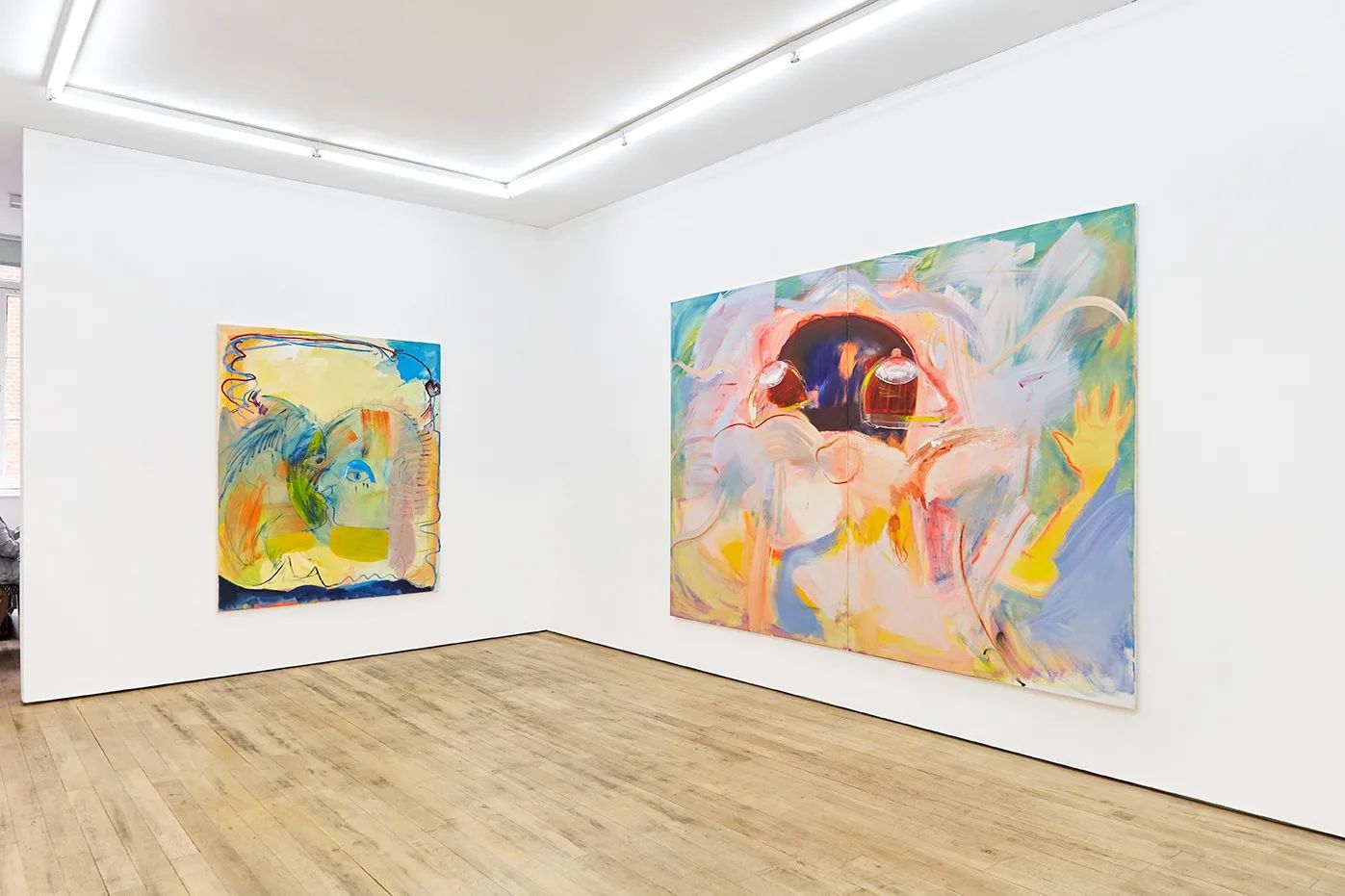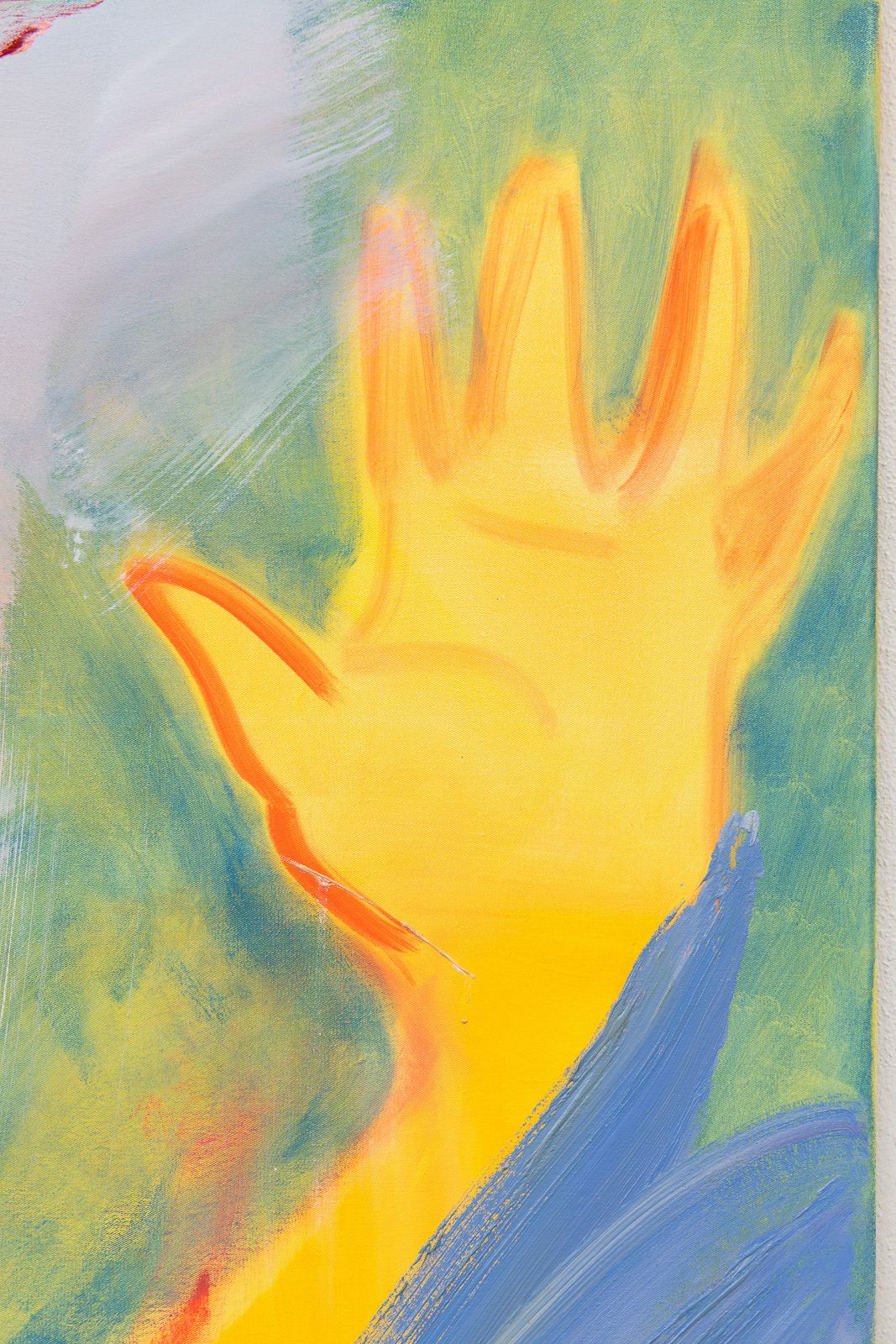Blue Hearts
Let’s momentarily imagine it’s 1902, I’m Carl Jung and you’re my experimental test subject, and we’re in the psychiatric clinic at the University of Zürich. I’m not yet a famous psychoanalyst; currently I specialise in word association. Ready? Flush.
It’s a good one, obviously, being so many-sided: from rosy-cheeked embarrassment to a promising hand in a card game, from cisterns to financial comfort to forcing something hidden into the open, pheasants from the bush. It seems unlikely that such divergent readings could coexist in five letters, but language is a slippery beast and I’m writing this in a country where one word, Morgen, means both ‘morning’ and ‘tomorrow’. If you chose Flush as the title of an art exhibition—as Aileen Murphy has for this quintet of recent paintings—there’s the risk of misreading, that the work might coexist embarrassingly with the viewer’s imagining of water sluicing round a u-bend, for instance. But that makes sense, too, because Murphy is interested in leveraging a degree of risk.
read more
In Real Bees Petting (all works 2020) the outward subject is a kissing couple, and the sense of romantic connection is heavily underscored by the presence of coloured lines of paint connecting the two heads, one of them leading to a little heart. Leave the description at that and you might be tempted to walk away. But Murphy has constructed this scenario in order to complicate it, to flush out hyphenate emotions within the simple theme of a kiss, to remind us that little is that straightforward between people. Start with the colour scheme, which is deeply off, murky, and bucks against bliss: the composition is effectively a figuration superimposed on a gauzy abstraction full of lemon yellow and adulterated blue-greens and hot smears of tangerine, which fill the lovers’ faces like so many oblique and conflicting emotions. One partner – their genders are ambiguous too – is staring right at the other (unromantic, uncommitted); the other, heavy-lidded and distorted of feature, doesn’t see this because they’re looking at us, including ourselves in a triangle of looking and suggesting that this situation, besides its unarticulated turmoil, is also about looking, uneasy looking. The heart is a dirty blue.
Twanging lines nevertheless rise from the rightward head, as if the figure were electrified by the nearby organ. Consider for a moment what an unguarded, uncool scenario this is. The artist, it appears, has said to herself: I’m going to get myself into a bit of trouble here, starting with the sort of thing a nine-year-old might scribble in a jotter. I’m going to let my cheeks flush, yours too; and then I’m going to dig myself out, drive something hidden towards the open, show my hand. And you’re going to be surprised.
Murphy’s practice is in this respect a journeying process of false-fronting and feinting and partial redemption, of saving the day, or it would be if such notions didn’t feel overtly major-key. Her paintings remain pitched somewhat into suspended unease, irresolution and imperfection even when they’ve fanned out complications. (A flush, while potentially a winning hand, can be bettered.) Pinking is a riot of hyper-feminine pinks, knowingly blunt in themselves, upon which Murphy has had the temerity to scribble a female figure. Again the verbal description is unpromising, and again it’s less than half the story. Start with orientation, which way the figure is facing; it’s not clear even clear how the facial features sit, whether you’re looking at a face or a cascade of hair. The left arm is a puzzle and maybe absent. The figure, seemingly naked, might be doing a yoga pose and/or looking back at us or ignoring us. Meanwhile all that over-determined floral pink asserts itself, as so often in Murphy’s practice, as a shorthand for someone’s inner world, though it’s hard to imagine whose, unless it’s an admirer’s. The door swings closed as soon as it’s opened, but we’ve got a foot jammed in it.
A danger is that such an approach turns into a formula. In the gale, with Gale shifts the stakes, and bears evidence of having been a quite different painting at some point in its evolution, like a novelist discovering who his main character is on the third draft. There is again a central figure here; but while its legs are identifiable, what constitutes its head – or contours of same – is up for debate. It looks adult and then from another angle it feels to swim in amniotic fluid. I can glimpse the profile of the towheaded brat from Calvin & Hobbes, but also intuit a quality of ominousness. The colour scheme bucks against the imagery regardless; again figurative order has been imposed on a freewheeling abstract painting without preventing the abstraction from humming away underneath. All of which is perhaps-indulgent rumination, but the point is that the painting compels rumination, inner traversing. It’s an experiential engine, and on a fundamental cleaving level art is either that or not, and if it’s not you won’t stay in front of it.
In order to perform such a task an artwork can’t be single-pointed, a breakable code, though it may scatter clues. Add to the hazy emphasis on bodies and romanticism in Flush the fleshy diptych O! O!, which has identifiable albeit floating cupcake breasts and an arm, and a central black mass that might be a head or a belly. Squint, though, and the main elements combine into a face. The colour scheme and fleet gestural handling very much recall mid-period de Kooning, and there might be traction in a female artist reclaiming the womanly figure from the male. But Murphy is not overtly a rhetorician except insofar as she argues for the virtues of pictorial incommensurability; nevertheless, the insinuation hovers. When you read a face into this painting, it suddenly appears to be waving at you, and looks – maybe – cheerily monstrous. The paint is dry, the work remains dynamic, but it has decided what it is, come to terms with itself. Only one of you is really going to change, to find out what you inwardly are by consulting a many-sided thing in a controlled environment, like a polyvalent word floated forth by an interlocutor. Now, happily, that’s your problem.
Text: Martin Herbert
Photos: Amanda Wilkinson Gallery
Courtesy: The artist and Amanda Wilkinson Gallery, London















